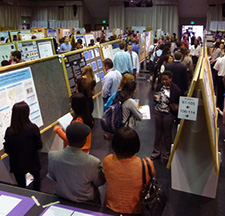Big Brainiacs
Engineer Corey Fleischer returns to URCAD to reach the next generation of innovators.
In 2005, an undergraduate researcher named Corey Fleischer 05, and 08, M.S., mechanical engineering, presented Microarchitectured Egg-Box Cores for Sandwich Panels at UMBCs Undergraduate Research and Creative Achievement Day (URCAD). If that name sounds familiar, you might recognize Fleischer as the winner of Discovery Channels engineering-based reality competition The Big Brain Theory: Pure Genius. After graduating, Fleischer went on to become a senior mechanical engineer at Lockheed Martin, earn five patents, and establish the Baltimore Foundery, a not-for-profit space that provides Baltimore innovators with access to industrial grade tools and training to use them.
Now Fleischer is returning to URCAD to inspire the next generation of innovators. As the events featured guest speaker, Fleischer will offer a window into his passion for problem-solving and quest for new knowledge. He recently said in an interview with UMBC, As long as I continue to learn, Ill be happy.
Undergraduates who share Fleischers excitement for learning, problem-solving and innovative thinking will present their research and creative work at the 18th annual URCAD, to be held on Wednesday, April 23, from 9:30 a.m. to 4:00 p.m.
Diane M. Lee, Vice Provost and Dean of Undergraduate Education, began URCAD with the vision that undergraduates should have an opportunity to engage in the full research experience, including presenting their results.
Janet McGlynn, Director of Communications and Outreach for the Office of Undergraduate Education, explains, URCAD is the largest of our annual undergraduate research symposia and includes the broadest range of student work. From original choreography to biochemistry and policy analysis to quantum computing, innovative student work is on display. Graduates tell us that their URCAD experience provided valuable preparation for the level of conference participation expected of them in graduate school.
McGlynn encourages all students, including those who are not yet involved in research, to attend URCAD. Students who attend URCAD find out what others are doing and gain ideas for their own innovative projects. It can be inspiring to see what others have accomplished right here on this campus, she says.
This year, the full-day event includes over 50 oral presentations and over 150 poster presentations, plus film screenings and artistic performances. These examples offer a glimpse of the exceptional work that UMBC students will present at URCAD:
Ke Coco Tang 14, political science, filmed interviews with members of Jordanian civil society to explore their reaction to the Syrian refugee population.
Fadaka Adebayo 15, health administration and policy, designed a linguistically and culturally appropriate social marketing toolkit to help older Hispanic and African American adults with type-2 diabetes improve their self-management practices.
Caleb Williams 15, dance, and Hannah Korangkool 15, design, created “Im Here,” an artistic performance that explores male gender expression and deconstructs definitions of gender and sexuality.
Cathy Hornback 14, computer science, and Abdullah Ali 14, information systems, built an adaptive interface to provide easier access to computers for users who experience difficulty with pointing.
Amy Rizkallah 14 and James Han 14, biological sciences, conducted protein chemical modifications on the amino acid residues of cromatine, a protein found in the venom of the South American rattlesnake, to determine where DNA-crotamine complexes are formed. Their research has potential implications for improving drug design.
A full list of presenters and abstracts can be found on the URCAD website.
(04/18/2014)

